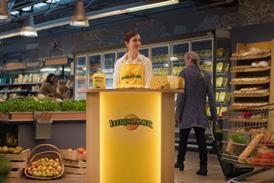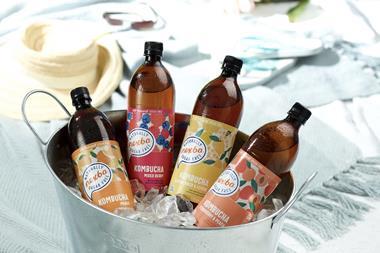They might be a fringe today but the growing number of exciting discounter formats will give rivals a pounding says Helen Gregory
There’s a perceived wisdom in the UK grocery market that one of the successes of the major multiples in recent years has been the way in which they have stifled the threat of the hard discounters. A combination of aggressive pricing, the launch of economy lines and a focus on customer service, range and quality have helped the supermarkets keep shoppers away from the likes of Aldi, Lidl and Netto.
The difficulties they have all faced growing in the UK shows that, when it comes to groceries, hard discounting just doesn’t work in this country.
That’s the argument, at least. And, on the face of it, there’s plenty of evidence to support that point of view. After all, despite plugging away at the UK for more than a decade now, hard discounters still have only a very small share of the overall market. According to IGD figures, their total sales in 2003 amounted to an estimated £4,579m, which is about 4% of the UK grocery sector.
Yet you discount the discounters at your peril. Why’s that? Well, for starters, these companies are growing their share - albeit from a small base. TNS figures show the hard discounters hold 4.7% of the UK market [52 w/e January 2 2005] - up from 4.5% last year. Lidl was up by 14%, Aldi by 7% and Netto by 11%. In addition, the chains are investing heavily in their UK businesses - Netto announced last month, for instance, that it planned to open 70 stores in Wales.
But what’s really fascinating about retailing in this country at the moment is what market share figures can’t tell you - and that’s the way in which other discount formats are booming and, in the process, helping fuel the discount culture.
Take Poundland. The retail chain now has 120 outlets across the UK and plans to open 30 stores a year for the next few years. It aims ultimately to have 400 to 500 outlets.
The store’s range is focused principally on non-food and with only minimal space allocated to grocery, it is not considered part of the core discount grocery sector.
However, branded manufacturers in drinks, snacks, confectionery and household goods are increasingly willing to collaborate with the chain.
Walkers and Cadbury now have a better understanding of what it is trying to do, says chairman and former Safeway chief executive Colin Smith. “They know we’re very strong on impulse lines,” he adds.
Poundland’s key point of difference is that the customer will always find new things on its shelves. Smith adds: “We can’t buy as well as Tesco but we have a consistent price point. We try to identify products and pack sizes that give consumers exceptional value for money and they’re often different to the multiples’ own.”
The UK’s top privately owned retailer is also a discounter. Although still relatively small, Scottish outfit Farmfoods has doubled in size over the past 10 years to more than 230 stores. When we publish The Grocer Top 50 ranking next week, readers will see that Farmfoods is on top again, proving that the frozen food chain’s canny trading and competitive prices are winning customers.
Then there’s the Bargain Booze franchise operation, owned by Irish wholesale giant BWG, which is not included in statistics, yet aims to open about 60 discount off-licences this year, taking its portfolio to 545 stores.
Despite operating in a competitive niche, Bargain Booze successfully encourages shoppers to trade up to bulk sizes, to increase purchases, and much of its beer is sold by the case. Marketing manager Mat Leach says: “Supermarkets compete once or twice a year at Christmas with loss leaders for a limited time, but we’ve got a point of difference because we’re a destination store that is cheaper overall - and all the time.”
Everywhere you look, it seems, there are exciting discount concepts being developed or expanded. Some are focused on grocery; many are not. But there’s no doubt these operators are nibbling away at the sales of the major grocery retailers - and some suppliers have woken up to the opportunity. Yet much of this business takes place at the fringes. So it never appears in data about the market, which means the discount sector is almost certainly more significant than many in the grocery industry think.
Can it get even bigger? Well, when you look at growth of discount formats such as TJ Hughes, Peacocks and Matalan, as well as the category-killing tactics of the likes of Tesco and Asda, it’s easy to understand why some experts are now talking about how we are starting to see a significant cultural shift in the way the Brits shop.
Today, consumers will buy T-shirts in a supermarket. They treat them as a disposable item that can be paired with Armani jeans, which they wear as they shop around for ever-cheaper food. And as they spend less on groceries, so they have more in their pockets to invest in exotic holidays abroad.
Little wonder that IGD chief executive Joanne Denney-Finch recently said the industry was living in what she dubbed “the age of the discounter”.
Yet when it comes to food, a central question remains: can the hard discounters exploit this new environment to expand their UK business?
Consultants M+M Planet Retail say that the discount format was the fastest-growing format in food retail globally in 2003 with 27% growth, compared with 21% in supermarkets. However, it predicts that the number of discount stores will only rise from 1,374 in the UK to 1,410 by 2008.
IGD research, meanwhile, indicates that the main reason people don’t shop in discounters is because they don’t have a conveniently located store to choose from, not because of any negative perception.
This theme is picked up by research published this week by Mintel, which shows many shoppers can’t be bothered to make a separate trip to a discounter to get part of their weekly food shop. Indeed, Mintel claims 53% of adults shop in discounters while only 2% use them for their main grocery shop.
Senior retail analyst Neil Mason says: “Discounters are clearly becoming popular for the occasional purchase. There has been a move towards cherrypicking, as the canny shopper simply heads to the discounter for a few selected good-value favourites. Ironically, it is the more affluent consumers who are more likely to opt for this way of shopping.”
Cherrypicking and inconvenient store locations are not their only problems. IGD’s research also found that 23% of shoppers won’t go to discounters because they don’t recognise the brands and 18% find the limited choice a barrier.
All of these issues are being addressed by the hard discounters - which are opening more stores (despite M+M’s predictions), putting more brands on their shelves and developing better ranges.
And as Aldi, Lidl and Netto slug it out with the big supermarkets, keep an eye on the other discount chains that will be quietly getting on with the job of building decent businesses on the fringes of grocery.
There’s a perceived wisdom in the UK grocery market that one of the successes of the major multiples in recent years has been the way in which they have stifled the threat of the hard discounters. A combination of aggressive pricing, the launch of economy lines and a focus on customer service, range and quality have helped the supermarkets keep shoppers away from the likes of Aldi, Lidl and Netto.
The difficulties they have all faced growing in the UK shows that, when it comes to groceries, hard discounting just doesn’t work in this country.
That’s the argument, at least. And, on the face of it, there’s plenty of evidence to support that point of view. After all, despite plugging away at the UK for more than a decade now, hard discounters still have only a very small share of the overall market. According to IGD figures, their total sales in 2003 amounted to an estimated £4,579m, which is about 4% of the UK grocery sector.
Yet you discount the discounters at your peril. Why’s that? Well, for starters, these companies are growing their share - albeit from a small base. TNS figures show the hard discounters hold 4.7% of the UK market [52 w/e January 2 2005] - up from 4.5% last year. Lidl was up by 14%, Aldi by 7% and Netto by 11%. In addition, the chains are investing heavily in their UK businesses - Netto announced last month, for instance, that it planned to open 70 stores in Wales.
But what’s really fascinating about retailing in this country at the moment is what market share figures can’t tell you - and that’s the way in which other discount formats are booming and, in the process, helping fuel the discount culture.
Take Poundland. The retail chain now has 120 outlets across the UK and plans to open 30 stores a year for the next few years. It aims ultimately to have 400 to 500 outlets.
The store’s range is focused principally on non-food and with only minimal space allocated to grocery, it is not considered part of the core discount grocery sector.
However, branded manufacturers in drinks, snacks, confectionery and household goods are increasingly willing to collaborate with the chain.
Walkers and Cadbury now have a better understanding of what it is trying to do, says chairman and former Safeway chief executive Colin Smith. “They know we’re very strong on impulse lines,” he adds.
Poundland’s key point of difference is that the customer will always find new things on its shelves. Smith adds: “We can’t buy as well as Tesco but we have a consistent price point. We try to identify products and pack sizes that give consumers exceptional value for money and they’re often different to the multiples’ own.”
The UK’s top privately owned retailer is also a discounter. Although still relatively small, Scottish outfit Farmfoods has doubled in size over the past 10 years to more than 230 stores. When we publish The Grocer Top 50 ranking next week, readers will see that Farmfoods is on top again, proving that the frozen food chain’s canny trading and competitive prices are winning customers.
Then there’s the Bargain Booze franchise operation, owned by Irish wholesale giant BWG, which is not included in statistics, yet aims to open about 60 discount off-licences this year, taking its portfolio to 545 stores.
Despite operating in a competitive niche, Bargain Booze successfully encourages shoppers to trade up to bulk sizes, to increase purchases, and much of its beer is sold by the case. Marketing manager Mat Leach says: “Supermarkets compete once or twice a year at Christmas with loss leaders for a limited time, but we’ve got a point of difference because we’re a destination store that is cheaper overall - and all the time.”
Everywhere you look, it seems, there are exciting discount concepts being developed or expanded. Some are focused on grocery; many are not. But there’s no doubt these operators are nibbling away at the sales of the major grocery retailers - and some suppliers have woken up to the opportunity. Yet much of this business takes place at the fringes. So it never appears in data about the market, which means the discount sector is almost certainly more significant than many in the grocery industry think.
Can it get even bigger? Well, when you look at growth of discount formats such as TJ Hughes, Peacocks and Matalan, as well as the category-killing tactics of the likes of Tesco and Asda, it’s easy to understand why some experts are now talking about how we are starting to see a significant cultural shift in the way the Brits shop.
Today, consumers will buy T-shirts in a supermarket. They treat them as a disposable item that can be paired with Armani jeans, which they wear as they shop around for ever-cheaper food. And as they spend less on groceries, so they have more in their pockets to invest in exotic holidays abroad.
Little wonder that IGD chief executive Joanne Denney-Finch recently said the industry was living in what she dubbed “the age of the discounter”.
Yet when it comes to food, a central question remains: can the hard discounters exploit this new environment to expand their UK business?
Consultants M+M Planet Retail say that the discount format was the fastest-growing format in food retail globally in 2003 with 27% growth, compared with 21% in supermarkets. However, it predicts that the number of discount stores will only rise from 1,374 in the UK to 1,410 by 2008.
IGD research, meanwhile, indicates that the main reason people don’t shop in discounters is because they don’t have a conveniently located store to choose from, not because of any negative perception.
This theme is picked up by research published this week by Mintel, which shows many shoppers can’t be bothered to make a separate trip to a discounter to get part of their weekly food shop. Indeed, Mintel claims 53% of adults shop in discounters while only 2% use them for their main grocery shop.
Senior retail analyst Neil Mason says: “Discounters are clearly becoming popular for the occasional purchase. There has been a move towards cherrypicking, as the canny shopper simply heads to the discounter for a few selected good-value favourites. Ironically, it is the more affluent consumers who are more likely to opt for this way of shopping.”
Cherrypicking and inconvenient store locations are not their only problems. IGD’s research also found that 23% of shoppers won’t go to discounters because they don’t recognise the brands and 18% find the limited choice a barrier.
All of these issues are being addressed by the hard discounters - which are opening more stores (despite M+M’s predictions), putting more brands on their shelves and developing better ranges.
And as Aldi, Lidl and Netto slug it out with the big supermarkets, keep an eye on the other discount chains that will be quietly getting on with the job of building decent businesses on the fringes of grocery.















No comments yet